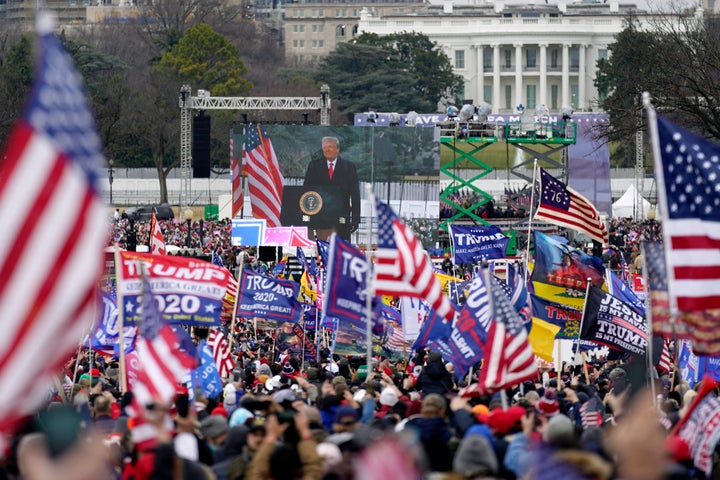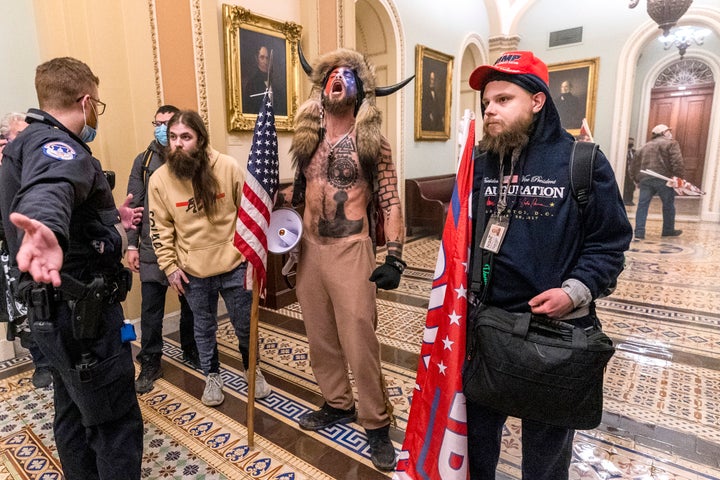Then-President Donald Trump falsely claimed more than 100 times that Democrats had “rigged” or “stolen” the 2020 election ahead of January’s deadly insurrectionist attack on the U.S. Capitol, a HuffPost analysis found.
In reviewing all of Trump’s tweets and speeches between Election Day on Nov. 3 and the Capitol riot on Jan. 6, HuffPost mapped out the rhetoric his followers absorbed as their defiance against President Joe Biden’s win mounted.
Over the course of those two months, Trump ― the most powerful politician in the country and, arguably, the entire world ― lied that the election was rigged at least 68 times and that it was stolen or in the process of being stolen at least 35 times. He made claims of voter fraud and ballot-counting irregularities more than 250 times, specifically making baseless claims that voting machines tossed or changed votes at least 45 times.
The Justice Department and election officials nationwide rejected such claims, stating there was no evidence of fraud or irregularities that would have overturned the election results. Nonetheless, Trump falsely declared victory at least 40 times, often claiming he won in a “landslide.”
He peddled these nuggets of disinformation during press conferences and rallies watched by millions of people, or on Twitter to his more than 88 million followers. HuffPost’s review included Trump’s many retweets, which can often be interpreted as endorsements. (His Twitter account was permanently suspended on Jan. 8 for violating the platform’s policy against inciting violence.)

Democrats and some Republicans have said Trump’s lies undoubtedly fomented the Capitol attack, which left at least five dead, including a police officer. Other Republicans ― even those who have helped spread the “Big Lie” of a stolen election ― have denounced Trump’s rhetoric but said they don’t believe he bears responsibility for the violence.
In an unlikely bid, House impeachment managers this week will need to convince at least 17 Republican senators to join their Democratic counterparts in convicting Trump of inciting the attack on the Capitol.
Most GOP senators have claimed the trial is unconstitutional because Trump is no longer in office and have indicated they will not vote to convict. (Prominent legal scholars have argued the trial is clearly constitutional.)
Some Trump loyalists in the Senate have rebutted Democrats by stating Trump called for “peace” before and during the attack. Trump, in fact, did appeal for peace during the Jan. 6 rally exactly once.
He also referenced the need to “fight” roughly 10 times during the rally, urged then-Vice President Mike Pence to overturn the election results at least seven times, and encouraged his supporters to “stop the steal” at least twice. Minutes later, hundreds of rallygoers would march toward the Capitol.
“We fight like hell,” Trump had told the crowd. “And if you don’t fight like hell, you’re not going to have a country anymore.”
The insurrectionists heeded Trump’s warning, fighting police officers and breaking down security barriers to get inside. Some smeared feces on the walls; others stole documents and property from lawmakers’ offices. Pipe bombs were discovered at the nearby headquarters of the Democratic National Committee and the Republican National Committee.
As the attack unfolded, Trump fired off a couple of brief tweets encouraging the rioters to be “peaceful.” He waited until an hour after the Capitol had been breached to finally call on the insurrectionists to leave. In a short video, Trump told them “we love you” and that they are “very special” but said they should “go home.”
By that point, senators and House members were already in lockdown and Pence had been evacuated.
“These are the things and events that happen when a sacred landslide election victory is so unceremoniously & viciously stripped away from great patriots who have been badly & unfairly treated for so long,” Trump tweeted later that night. “Go home with love & in peace. Remember this day forever!”

In the months leading up to the election, Trump laid the foundation to claim the process had been rigged against him and that certain types of ballots would be fraudulent. His comments between Election Day and Jan. 6 were, in many ways, an extension of this disinformation push.
Throughout his presidency, Trump incessantly bashed the media as the “enemy of the people” and “fake news.” The months leading up to the Capitol riot were no different. Between Election Day and Jan. 6, Trump attacked the media at least 30 times.
“All of us here today do not want to see our election victory stolen by emboldened radical left Democrats ... and stolen by the fake news media,” Trump said during the Jan. 6 rally. “That’s what they’ve done and what they’re doing. We will never give up. We will never concede.”
Later that afternoon, Capitol rioters targeted members of the press during their attack, scratching “murder the media” into a door of the building, punching a photographer and destroying at least one news outlet’s equipment.
“We are the news now!” one man reportedly shouted as rioters fashioned one of the camera cords into a noose.

